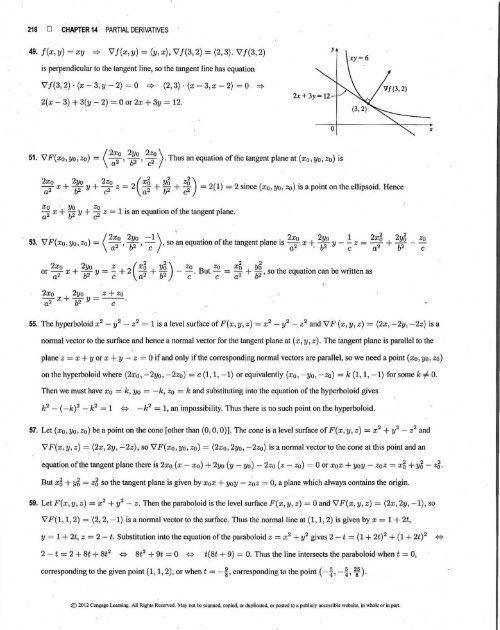Exercicios resolvidos James Stewart vol. 2 7ª ed - ingles
Create successful ePaper yourself
Turn your PDF publications into a flip-book with our unique Google optimized e-Paper software.
218 D CHAPTER 14 PARTIAL DERIVATIVES<br />
49. f(x, y) = xy => '\1 f(x, y) = (y, x}, '\1 !(3, 2) = (2, 3). '\1 !(3, 2)<br />
is perpendicular to the tangent line, so the tangent line has equation<br />
'\1](3, 2) · (x - 3, y- 2} = 0 => (2, 3) · (x- 3, x- 2) = 0 =><br />
2(x - 3) + 3(y - 2) = 0 or 2x + 3y = 12.<br />
I 2xo 2yo 2zo J . .<br />
51. '\1 F(xo, yo, zo) = \ (i2• 1)2• C2 . . Thus an equatiOn oflhe tangent plane at (x0 , y0 , zo) 1s<br />
2xo 2yo 2zo ( x5 y~ z~ ) ( ) . . . . .<br />
(i2 x + 1)2 Y + C2 z = 2 a 2 + b 2 + c 2 = 2 1 = 2 smce (xo, yo, zo) IS a pomt on the elhps01d. Hence<br />
xo · Yo zo<br />
a<br />
c<br />
2 x + b 2<br />
y + 2 z = 1s an equation o e tangent p ane.<br />
1 . . fth 1<br />
( ) I 2xo 2yo - 1 J ' . . 2xo 2yo 1 2x5 2y5 zo<br />
53. '\1 F xo, yo, zo = \ (i2• 1)2, c , so an equatiOn of the tangent plane 1s (i2 x -1: 1)2 y - c z = (i2 + 1)2 - c<br />
2xo 2yo z ( x 2 y 2 ) zo zo x 2 y 2 . .<br />
or - 2<br />
x + -b 2<br />
y =- + 2 -% + b~ - - . But - = -% + b~, so the equat1on can be written as<br />
a c a c c a<br />
2xo 2yo z + zo<br />
- x+ - y = --.<br />
a 2 b 2 c<br />
55. The hyperboloid x 2 - y 2 - z 2 = 1 is a level surface of F(x, y, z) = x 2 - y 2 - . z 2 and '\1 F (x, y , z) = (2x, -2y, -2z) is a<br />
nonnal vector to the surface and hence a nonnal vector for the tangent plane at (x, y, z). The tangent plane is parallel to the<br />
plane z = x + y or x + y- z = 0 if and only if the corresponding normal vectors are parallel, so we ne<strong>ed</strong> a point (xo, yo, zo)<br />
on the hyperboloid wh~re (2xo, -2yo, - 2zo) = c (1, 1·, ....,-1) or equivalently (xo, - yo, -zo) = k (1, 1, -1) for some k ¥: 0.<br />
Then we must have xo = k , yo = - k , zo = k and substituting into the equation of the hyperboloid gives<br />
k 2 - ( -k) 2 ~ k 2 = 1 {:} - k 2 = 1, an impossibility. Thus there is no such point on the hyperboloid.<br />
57. Let (xo, y 0 , z 0 ) be a point on the cone [other than {0, 0, 0)]. The cone is a level surface of F(x, y, z) = x 2 + y 2 - z 2 and<br />
'\1 F(x, y, z) = (2;t, 2y, - 2z), so '\1 F(xo, yo, zo) = (2xo, 2yo, -2zo) is a nomial vector to the cone at this point and an<br />
equation of the tangent plane there is 2xo (x - xo) + 2yo (y - y 0 ) - 2zo (z - zo) = 0 or xox + yoy - zoz = x~ + y5- z5.<br />
But x& + v5 = za so the tangent plane is given by xox + YOY - ZoZ = 0, a plane which always contains the origin.<br />
59. Let F(x, y , z) = x 2 + y 2 - z. Then the paraboloid is the level surface F (x, y, z) = 0 and '\1 F (x, y ; z) = (2x,2y, -1), so<br />
'\1 F(1, 1, 2) = '(2, 2,-1) is a nonnal vector to the surface. Thus the normal line at (1, 1, 2) is given by x = 1 + 2t,<br />
y = 1 + 2t, z = 2-t. Substitution into the equation of the paraboloid z = x 2 + y~ gives 2-t = {1 + 2t) 2 + {1 + 2t? {:}<br />
2 - t = 2 + 8t + Bf {:} 8t 2 + 9t = 0 {:} t(Bt + 9) = 0. Thus the line intersects the paraboloid when t = 0,<br />
corresponding to the given point (1, 1, 2), or when t = - ~,corres ponding to the point (-%, -~, ¥).<br />
I<br />
@ 2012 Cmgnge Learning. All Rights Hescrvcd. May not be scann<strong>ed</strong>, copi<strong>ed</strong>, or durlicat<strong>ed</strong>, or poSicd to a publicly occC3siblc website. in whole or in p.u1.


